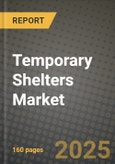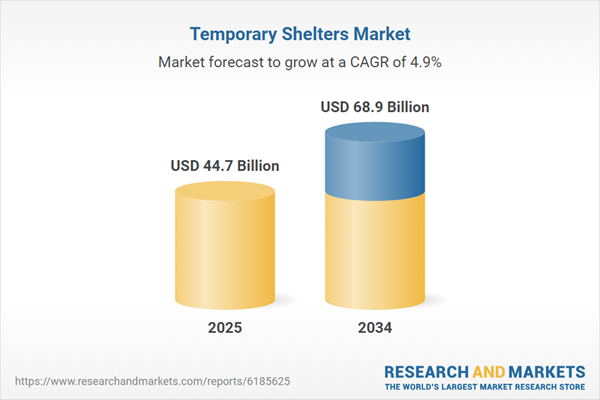The Temporary Shelters Market plays a crucial role in humanitarian response, disaster relief, migrant housing, and emergency preparedness. These shelters are designed for rapid deployment, portability, and adaptability to varying climates and terrain. They serve displaced populations affected by natural disasters, armed conflicts, homelessness, and pandemics. Key materials used in construction include lightweight steel frames, PVC-coated fabrics, modular plastics, and insulated panels. With the growing frequency of extreme weather events, forced migrations, and global health emergencies, governments, NGOs, and private contractors are increasingly investing in scalable and cost-efficient shelter systems. The market also supports other use cases, including military camps, outdoor medical stations, event housing, and remote workforce accommodations. As needs diversify and evolve, there is a rising emphasis on shelters that combine durability with sustainability, rapid assembly, and reusability.
The temporary shelters market saw increased demand due to a combination of global crises and climate-induced displacement. Notable market developments included the deployment of modular, solar-powered shelters in post-disaster zones and conflict-ridden regions. Humanitarian agencies adopted more durable and insulated designs to address long-term occupancy needs, particularly in refugee settlements. There was also a growing reliance on digital design tools and prefabrication technologies to streamline logistics and assembly in remote or hard-to-reach locations. Furthermore, public-private partnerships expanded, particularly in regions facing urban homelessness, leading to the pilot use of shelter pods in city parks and transitional housing projects. As climate resilience and social housing became a policy focus in developed economies, more countries began testing advanced, weatherproof shelter prototypes with integrated sanitation and heating modules to meet safety and dignity standards for vulnerable populations.
The temporary shelters market is expected to align more closely with smart infrastructure and sustainability trends. Shelters will likely incorporate modular IoT systems for temperature control, structural monitoring, and real-time occupancy management. With funding agencies pushing for carbon-neutral aid operations, manufacturers are expected to innovate around biodegradable materials, recyclable components, and solar-integrated shelter units. Emerging economies will drive market growth as urbanization pressures collide with social inequality, creating urgent demand for transitional housing. Additionally, governments may increasingly stockpile shelters as part of national emergency preparedness programs. The expansion of climate migration zones will create new demand corridors in South Asia, Sub-Saharan Africa, and parts of Latin America. As temporary shelters begin to serve longer-term needs, the industry will have to balance agility with livability, enabling dignified, secure, and environmentally conscious solutions at scale.
Key Insights: Temporary Shelters Market
- Smart shelters equipped with solar panels, water filtration systems, and IoT-based climate control are gaining traction, offering off-grid functionality and improved occupant comfort in disaster zones and refugee settlements.
- Prefabricated modular units are being favored over traditional tent systems due to faster deployment times, increased weather resistance, and customizable configurations for medical, educational, and housing needs.
- Sustainable material innovation is on the rise, with new shelters incorporating recyclable plastics, biodegradable insulation, and low-carbon steel to reduce environmental impact during mass deployments.
- Urban areas are piloting micro-shelter and pod housing initiatives for the homeless, supported by local governments and NGOs seeking scalable, movable solutions to reduce street homelessness.
- 3D-printed shelter prototypes are emerging in pilot projects, allowing rapid production of sturdy, low-cost units using locally available materials and minimal labor in high-risk disaster regions.
- Increased frequency and intensity of natural disasters are accelerating the need for rapid-response housing systems that can be deployed within hours to support displaced communities.
- Rising global refugee and internally displaced populations are prompting international aid organizations and governments to expand investments in scalable, longer-term shelter infrastructure.
- Government-funded initiatives to address homelessness in urban settings are supporting the growth of modular, transitional shelters as part of broader social housing strategies.
- Technological advancements in modular construction, logistics optimization, and lightweight materials are reducing costs and improving deployment speed, making shelters more accessible to underserved regions.
- Balancing rapid deployability with durability remains a key challenge, as many shelters deteriorate under prolonged exposure or harsh conditions, limiting their use in extended crises and forcing repeated replacements, which strain budgets and operational logistics.
Temporary Shelters Market Segmentation
By Type
- Homeless Shelter
- Emergency Shelter
By Size
- Small
- Medium
- Large
By Application
- Personnel
- Vehicle Mounted
- Medical Facility Base
- Aircraft Base
- Command Post
- Other Applications
Key Companies Analysed
- Sprung Structures
- Mahaffey USA
- Losberger De Boer Group
- Röder HTS Höcker GmbH
- Liri Tent Technology Co., Ltd.
- Alaska Structures
- HTS TENTIQ
- Pacific Domes Inc.
- Shelter Structures Inc.
- WeatherPort Shelter Systems
Temporary Shelters Market Analytics
The report employs rigorous tools, including Porter’s Five Forces, value chain mapping, and scenario-based modeling, to assess supply-demand dynamics. Cross-sector influences from parent, derived, and substitute markets are evaluated to identify risks and opportunities. Trade and pricing analytics provide an up-to-date view of international flows, including leading exporters, importers, and regional price trends.Macroeconomic indicators, policy frameworks such as carbon pricing and energy security strategies, and evolving consumer behavior are considered in forecasting scenarios. Recent deal flows, partnerships, and technology innovations are incorporated to assess their impact on future market performance.
Temporary Shelters Market Competitive Intelligence
The competitive landscape is mapped through proprietary frameworks, profiling leading companies with details on business models, product portfolios, financial performance, and strategic initiatives. Key developments such as mergers & acquisitions, technology collaborations, investment inflows, and regional expansions are analyzed for their competitive impact. The report also identifies emerging players and innovative startups contributing to market disruption.Regional insights highlight the most promising investment destinations, regulatory landscapes, and evolving partnerships across energy and industrial corridors.
Countries Covered
- North America - Temporary Shelters market data and outlook to 2034
- United States
- Canada
- Mexico
- Europe - Temporary Shelters market data and outlook to 2034
- Germany
- United Kingdom
- France
- Italy
- Spain
- BeNeLux
- Russia
- Sweden
- Asia-Pacific - Temporary Shelters market data and outlook to 2034
- China
- Japan
- India
- South Korea
- Australia
- Indonesia
- Malaysia
- Vietnam
- Middle East and Africa - Temporary Shelters market data and outlook to 2034
- Saudi Arabia
- South Africa
- Iran
- UAE
- Egypt
- South and Central America - Temporary Shelters market data and outlook to 2034
- Brazil
- Argentina
- Chile
- Peru
Research Methodology
This study combines primary inputs from industry experts across the Temporary Shelters value chain with secondary data from associations, government publications, trade databases, and company disclosures. Proprietary modeling techniques, including data triangulation, statistical correlation, and scenario planning, are applied to deliver reliable market sizing and forecasting.Key Questions Addressed
- What is the current and forecast market size of the Temporary Shelters industry at global, regional, and country levels?
- Which types, applications, and technologies present the highest growth potential?
- How are supply chains adapting to geopolitical and economic shocks?
- What role do policy frameworks, trade flows, and sustainability targets play in shaping demand?
- Who are the leading players, and how are their strategies evolving in the face of global uncertainty?
- Which regional “hotspots” and customer segments will outpace the market, and what go-to-market and partnership models best support entry and expansion?
- Where are the most investable opportunities - across technology roadmaps, sustainability-linked innovation, and M&A - and what is the best segment to invest over the next 3-5 years?
Your Key Takeaways from the Temporary Shelters Market Report
- Global Temporary Shelters market size and growth projections (CAGR), 2024-2034
- Impact of Russia-Ukraine, Israel-Palestine, and Hamas conflicts on Temporary Shelters trade, costs, and supply chains
- Temporary Shelters market size, share, and outlook across 5 regions and 27 countries, 2023-2034
- Temporary Shelters market size, CAGR, and market share of key products, applications, and end-user verticals, 2023-2034
- Short- and long-term Temporary Shelters market trends, drivers, restraints, and opportunities
- Porter’s Five Forces analysis, technological developments, and Temporary Shelters supply chain analysis
- Temporary Shelters trade analysis, Temporary Shelters market price analysis, and Temporary Shelters supply/demand dynamics
- Profiles of 5 leading companies - overview, key strategies, financials, and products
- Latest Temporary Shelters market news and developments
Additional Support
With the purchase of this report, you will receive:- An updated PDF report and an MS Excel data workbook containing all market tables and figures for easy analysis.
- 7-day post-sale analyst support for clarifications and in-scope supplementary data, ensuring the deliverable aligns precisely with your requirements.
- Complimentary report update to incorporate the latest available data and the impact of recent market developments.
This product will be delivered within 1-3 business days.
Table of Contents
Companies Mentioned
- Sprung Structures
- Mahaffey USA
- Losberger De Boer Group
- Röder HTS Höcker GmbH
- Liri Tent Technology Co. Ltd.
- Alaska Structures
- HTS TENTIQ
- Pacific Domes Inc.
- Shelter Structures Inc.
- WeatherPort Shelter Systems
Table Information
| Report Attribute | Details |
|---|---|
| No. of Pages | 160 |
| Published | October 2025 |
| Forecast Period | 2025 - 2034 |
| Estimated Market Value ( USD | $ 44.7 Billion |
| Forecasted Market Value ( USD | $ 68.9 Billion |
| Compound Annual Growth Rate | 4.9% |
| Regions Covered | Global |
| No. of Companies Mentioned | 10 |









